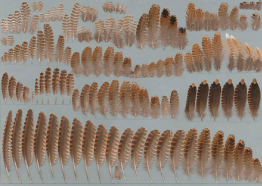







Material and Methodology
 The basis for this work is a large feather collection, which I have assembled over 15 years with the help of many institutions, and which is stored at the Zoological Museum of the University of Hamburg. From there the needed material is borrowed. Missing species are loaned from other collections. The plan is to illustrate and describe the feathers of nearly all Eurepean bird species (more than 500) on about 800 pages of the format 24 x 34 cm. Only a few species may have to be left out due to the lack of material. Note: In 2001, the project was extended to cover the entire Western Palearctic (Europe, North Africa and The Middle East).
The basis for this work is a large feather collection, which I have assembled over 15 years with the help of many institutions, and which is stored at the Zoological Museum of the University of Hamburg. From there the needed material is borrowed. Missing species are loaned from other collections. The plan is to illustrate and describe the feathers of nearly all Eurepean bird species (more than 500) on about 800 pages of the format 24 x 34 cm. Only a few species may have to be left out due to the lack of material. Note: In 2001, the project was extended to cover the entire Western Palearctic (Europe, North Africa and The Middle East).
The main part of the book will be formed by more than 600 large color photos, which will show a full set of primaries, secondaries and tail feathers as well as a selection of coverts and body feathers of each bird species. The feathers of most passerine species will be illustrated in natural size for easy comparison. Larger species will be shown in reduced size, but it attempts to show similar or related species in the same scale. The feather types on different illustrations will always be arranged in the same way. Since a bird has two symmetrical halves, only the feathers of the right body half are shown so that the illustrations are easier to compare with each other. If the sexes and/or age groups show considerable differences, two or even three full illustrations may be dedicated to one species. Minor variations of sex and age that are restricted to only a few feathers will be illustrated in smaller illustrations within the text section.
A lot of effort has gone into determining the best color reproduction procedure. The feathers are glued with their calamus on grey cardboard and scanned directly with a high resolution scanner that is especially calibrated for this task. This method proved to yield better and more repeatable results than taking photographs with a camera, although it is considerably more time consuming. The feather sheets of large species measure up to 105 x 150 cm and have to be scanned in up to 32 separate pieces to be later pasted together in an imaging program. There are some problems that can occur during scanning and especially during printing, such as Moiré patterns and Newton rings caused by interferences of the feather structure with the scanner resolution and screening resolution, but these problems were solved with the help of experts.
The species accounts will be facing the corresponding illustrations for easy references. They are written in a compact style without unnecessary verbs and articles to keep them as short as possible. The text is subdivided into 4 paragraphs:
1. The first paragraph describes the coloration of the feathers, taking into account the differences between the sexes and age groups if relevant. The color names will be illustrated by color patterns in the introduction of the book and will be as simple as possible.
2. The second paragraph treats structural aspects. It states the number of primaries, secondaries and tail feathers, the position of the longest ones, the length differences to the shortest inner and outer ones (expressed in percent of the longest ones), and their shapes (emarginations, tip shapes, exceptionally wide or narrow feathers etc.).
3. The third paragraph gives the measurements of the longest primary and longest tail feather. In addition to the measurements taken directly on isolated feathers, a method has been developed to convert the wing and tail measurements from other sources into feather measurements.
4. The fourth paragraph lists similar species and their distinguishing characteristics. In difficult cases, the problematic species may be compared in a table.
The species accounts will be preceded by family accounts, which summarize the common and typical features of each family. When a feather or plucking is found, a rough identification key by size should help to determine to which families the feather may belong by limiting the number of families in question. This key is only for flight and tail feathers. In order to use the key, it is necessary to know the approximate position of the feather in the wing (which is easy with a little practice) and measure it. By comparing the measurement with a diagram, one arrives at a certain size range, for example "Thrush-size". A list will specify all the families and species that fall into that size category and the user can then check out the respective family accounts and species accounts to fine-tune the identification. As a last verification, the similar species listed in the last paragraph of each species account can be referred to in order to see if any confusion with them is likely.
 English
English Deutsch
Deutsch Français
Français Italiano
Italiano 日本語
日本語 Español
Español Português
Português Russian
Russian Chinese (Simp.)
Chinese (Simp.) Tchèque
Tchèque Polonais (seulement boutique)
Polonais (seulement boutique)